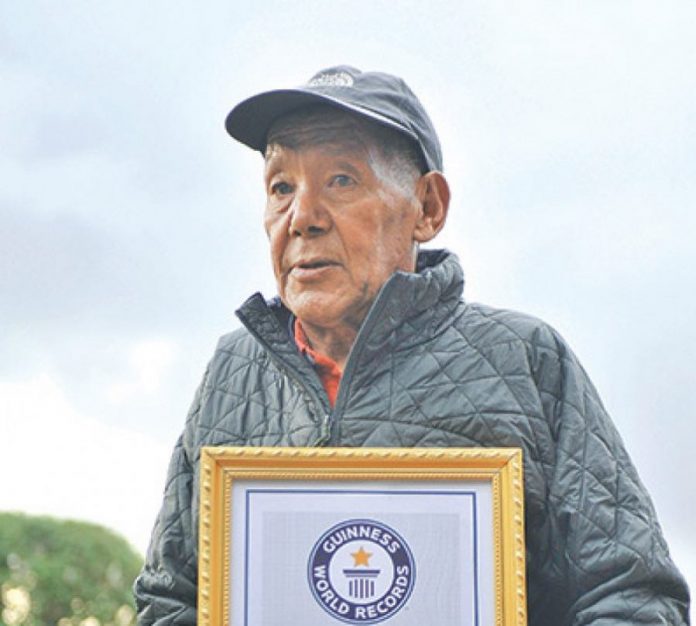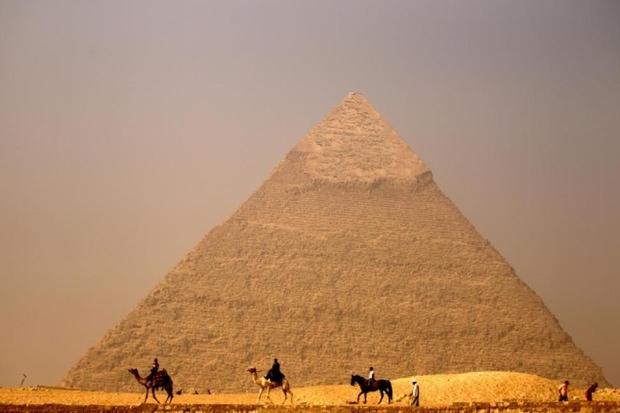Thaneshwor Guragain, a manager at Seven Summit Treks, recalls Ang Rita Sherpa thinking that the end was near in April 2017 when he was being treated at a hospital in Kathmandu after he suffered a stroke.
He then remembers an interview of the famed mountaineer years ago where he said he wanted a Guinness World Record certificate.
“We immediately wrote to the Guinness World Records office, presenting the facts and figures. And in June 2017, the certificate arrived, 21 years after his last ascent on Everest,” said Guragain.
Ang Rita Sherpa survived that stroke and lived to hold the certificate proudly in his hands.
Ang Rita, who had climbed Mt Everest 10 times without bottled oxygen, died after a lengthy illness in Kathmandu on Monday. He was 72.
He is survived by two sons and a daughter.
“He was soft-spoken and normally did not speak much. When we asked questions he answered in few words,” recalls journalist Narayan Wagle. “In our early days of journalism, Ramyata Limbu and I would chase Ang Rita a lot. Whenever he came to Kathmandu, we would meet him and ask him about his mountaineering exploits.”
A story appeared in Kantipur daily, the sister publication of the Post, after his eighth ascent of Everest in May 1993 and the newspaper gave him the epithet ‘Snow Leopard’. The world today knows him by this name.
“I don’t remember the date exactly. But, we had featured his valour and bravery. He was unstoppable. A man who frequently reached an altitude of 8,848 metres without supplementary oxygen,” said Wagle, who later became the editor of Kantipur.
“It’s a great loss for the mountaineering community and the nation.”
Ang Tshering Sherpa, former president of Nepal Mountaineering Association, and his good friend, told the Post that Ang Rita had lately been suffering from a brain problem.
He breathed his last in his daughter’s home in Jorpati, he said.
His body has been kept at a Sherpa Gomba and he will be cremated on Wednesday as per Sherpa tradition, said Ang Tshering.
Ang Rita, a native of Thamo village in Solukhumbu, last stood atop the world’s tallest mountain in 1996, the 10th time without supplementary oxygen.
His first eight-thousander was the 8,167-metre Dhaulagiri in western Nepal with a Belgian expedition in 1982. The mountain is considered one of the more difficult mountains to climb.
“A young, tall and strong man, he succeeded in his first attempt,” recalls Ang Tshering.
His Dhaulagiri success led him to the world’s highest peak in 1983 where he guided an American team, he said.
After that, he never looked back.
The Guinness World Records in 2017 recognised him as the only person on the planet to have climbed Everest 10 times without bottled oxygen.
He was also recognised by Guinness as the first man to climb Everest in winter without supplementary oxygen in December 1987.
In Nepal, the state honoured him with Gorkha Dakshin Bahu First Class and the Tri Shakti Patta First Class.
“In the last three decades, no one has succeeded in breaking his record even if there were several attempts made to climb in winter,” said Guragain. “Anyone can easily imagine how difficult it was to climb Everest without supplementary oxygen.”
Ang Rita claimed that he felt more comfortable climbing without bottled oxygen.
Kami Rita Sherpa, who holds the record for most ascents of Mt Everest, remembers Ang Rita as a strong and dedicated man.
“His dedication as a professional climber can never be described in words. It needs determination, passion and courage to climb Everest without the use of supplementary oxygen. Ang Rita did it 10 times,” he told the Post.
Kami Rita, who has climbed Everest 24 times, said Ang Rita is a source of inspiration for many foreign and Nepali climbers.
“It’s hard to break his record now.”
Ang Rita was in bad health in his village in 1999. Ang Tshering remembers how he hired a chopper and flew him to a hospital in Kathmandu for treatment.
Despite poor health, his friends and juniors in the mountaineering fraternity complained, Ang Rita was too fond of drinking.
Ang Rita’s health worsened after the death of his eldest son in April 2012. Karsang Namgyal Sherpa, an experienced climber, who had conquered the 8848-metre peak several times, had collapsed at Everest base camp due to altitude sickness.
“Doctors had said he had developed hydrocephalus meaning water had collected in his brain,” Ang Tshering said. “It was never proven how the illness developed, but we suspected it may have been because of his long exposure to high altitude without oxygen.”
Despite his stature, fame and records, he struggled financially throughout his life.
“Ang Rita was a national hero but struggled financially,” said Kami Rita.
After Ang Rita stopped climbing in 1996 due to poor health, he struggled to manage his finances.
“We [Nepal Mountaineering Association] even provided him a certain salary by appointing him as a manager and mobilising him at Everest base camp,” said Ang Tshering.
After he was forced to retire from the job due to his worsening health, the association appointed him ceremonial director with a salary of Rs15,000 per month.
Besides that, Nepal Mountaineering Association also supported him with nearly Rs1 million financial grant for his treatment but the government never supported him.
“He struggled. He made the country proud. But the Nepal government knew nothing about his situation,” lamented Kami Rita. “There are many Sherpas who die for the nation but their contribution is barely recognised.”













